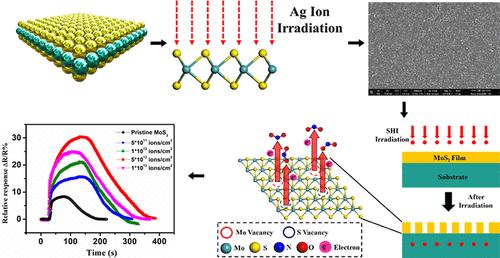Our official English website, www.x-mol.net, welcomes your
feedback! (Note: you will need to create a separate account there.)
Enhanced NO2 Gas Sensing in Nanocrystalline MoS2 via Swift Heavy Ion Irradiation: An Experimental and DFT Study
ACS Sensors ( IF 8.2 ) Pub Date : 2024-10-23 , DOI: 10.1021/acssensors.4c01812 Aditya Kushwaha, Neetu Raj Bharti, Anuj Sharma, Sanjay Kumar Kedia, Govind Gupta, Neeraj Goel
ACS Sensors ( IF 8.2 ) Pub Date : 2024-10-23 , DOI: 10.1021/acssensors.4c01812 Aditya Kushwaha, Neetu Raj Bharti, Anuj Sharma, Sanjay Kumar Kedia, Govind Gupta, Neeraj Goel

|
Nanostructured transition metal dichalcogenides (TMDs) like MoS2 hold promise for gas sensing applications due to their exceptional properties. However, limitations exist in maximizing sensor performance, such as limited active sites for gas interaction and sluggish response/recovery times. This study explores swift heavy ion (SHI) irradiation as a strategy to address these challenges in MoS2-based NO2 gas sensors. MoS2 nanoflakes were fabricated and subsequently irradiated with 120 MeV silver (Ag) ions to induce structural and morphological modifications. Characterization techniques confirmed the formation of Mo and S vacancies within the MoS2 lattice due to irradiation. Significantly, SHI irradiation resulted in a remarkable enhancement of approximately 3 times improvement in sensing response compared to pristine MoS2 sensors. Additionally, the irradiated sensors exhibit substantial improvements in both response and recovery times for NO2 detection. SHI irradiation resulted in the formation of self-affine nanostructures and increased grain fragmentation as fluence rises. This enhanced surface area is hypothesized to promote gas-sensor response. To gain deeper insights into the underlying mechanism, first-principles calculations were employed. These calculations suggest that electron transfer occurs from the MoS2 surface to the NO2 molecule during interaction. Furthermore, the irradiation-induced vacancies facilitate stronger NO2 adsorption on the MoS2 surface compared to the pristine sample. This work demonstrates the effectiveness of SHI irradiation in engineering defects within MoS2 nanoflakes, leading to significantly improved NO2 gas-sensing performance. This approach offers a promising avenue for developing next-generation TMD-based gas sensors with enhanced sensitivity, response times, and stability.
中文翻译:

通过快速重离子辐照增强纳米晶 MoS2 中的 NO2 气体传感:实验和 DFT 研究
MoS2 等纳米结构过渡金属硫化物 (TMD) 因其卓越的性能而有望用于气体传感应用。然而,在最大限度地提高传感器性能方面存在局限性,例如气体相互作用的活性位点有限和响应/恢复时间缓慢。本研究探讨了快速重离子 (SHI) 照射作为解决基于 MoS2 的 NO2 气体传感器中这些挑战的策略。制备了 MoS2 纳米薄片,随后用 120 MeV 银 (Ag) 离子照射以诱导结构和形态修饰。表征技术证实了由于辐照,MoS2 晶格内形成了 Mo 和 S 空位。值得注意的是,与原始的 MoS2 传感器相比,SHI 照射导致传感响应显着提高约 3 倍。此外,辐照传感器在 NO2 检测的响应和恢复时间方面都表现出显著改善。SHI 辐照导致自仿射纳米结构的形成,并随着通量的增加而增加晶粒碎裂。假设这种增强的表面积可以促进气体传感器响应。为了更深入地了解潜在机制,采用了第一性原理计算。这些计算表明,电子在相互作用过程中从 MoS2 表面转移到 NO2 分子。此外,与原始样品相比,辐照诱导的空位有助于 NO2 在 MoS2 表面上更强的吸附。 这项工作证明了 SHI 辐照对 MoS2 纳米薄片内工程缺陷的有效性,从而显着提高了 NO2 气敏性能。这种方法为开发具有更高灵敏度、响应时间和稳定性的下一代基于 TMD 的气体传感器提供了一条有前途的途径。
更新日期:2024-10-24
中文翻译:

通过快速重离子辐照增强纳米晶 MoS2 中的 NO2 气体传感:实验和 DFT 研究
MoS2 等纳米结构过渡金属硫化物 (TMD) 因其卓越的性能而有望用于气体传感应用。然而,在最大限度地提高传感器性能方面存在局限性,例如气体相互作用的活性位点有限和响应/恢复时间缓慢。本研究探讨了快速重离子 (SHI) 照射作为解决基于 MoS2 的 NO2 气体传感器中这些挑战的策略。制备了 MoS2 纳米薄片,随后用 120 MeV 银 (Ag) 离子照射以诱导结构和形态修饰。表征技术证实了由于辐照,MoS2 晶格内形成了 Mo 和 S 空位。值得注意的是,与原始的 MoS2 传感器相比,SHI 照射导致传感响应显着提高约 3 倍。此外,辐照传感器在 NO2 检测的响应和恢复时间方面都表现出显著改善。SHI 辐照导致自仿射纳米结构的形成,并随着通量的增加而增加晶粒碎裂。假设这种增强的表面积可以促进气体传感器响应。为了更深入地了解潜在机制,采用了第一性原理计算。这些计算表明,电子在相互作用过程中从 MoS2 表面转移到 NO2 分子。此外,与原始样品相比,辐照诱导的空位有助于 NO2 在 MoS2 表面上更强的吸附。 这项工作证明了 SHI 辐照对 MoS2 纳米薄片内工程缺陷的有效性,从而显着提高了 NO2 气敏性能。这种方法为开发具有更高灵敏度、响应时间和稳定性的下一代基于 TMD 的气体传感器提供了一条有前途的途径。


















































 京公网安备 11010802027423号
京公网安备 11010802027423号